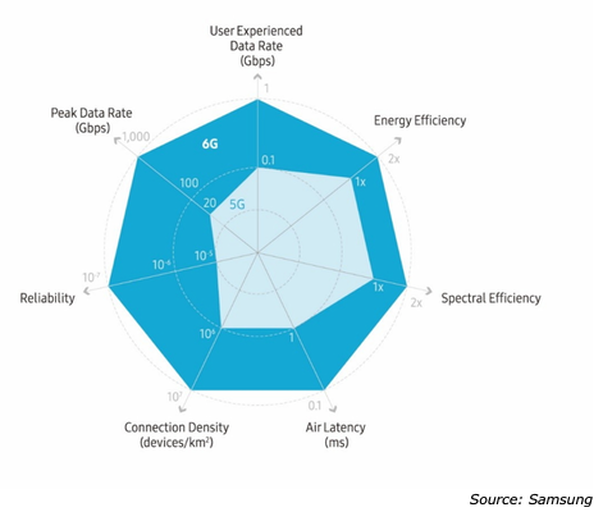Vertical Divider
With 5G Rolling Out Slowly, Samsung Starts Designing 6G
July 19, 2020
Even with 5G commercialization at its initial stage, the telecom world is preparing for 6G because it typically takes around 10 years from the start of research to commercialization of a new generation of communications technology,” said Sunghyun Choi, Head of Samsung’s Advanced Communications Research Center.
“Samsung defines three categories of requirements that have to be met to realize 6G services – performance, architectural and trustworthiness requirements.” The company will begin 6G research in "full-scale" this year, said Choi, with aims to have work done on defining and developing technical standards started in 2021.
Examples of Samsung defined 6G performance requirements, include:
Figure 1: Key Performance Requirements Between 6G (Darker Blue) And 5G:
July 19, 2020
Even with 5G commercialization at its initial stage, the telecom world is preparing for 6G because it typically takes around 10 years from the start of research to commercialization of a new generation of communications technology,” said Sunghyun Choi, Head of Samsung’s Advanced Communications Research Center.
“Samsung defines three categories of requirements that have to be met to realize 6G services – performance, architectural and trustworthiness requirements.” The company will begin 6G research in "full-scale" this year, said Choi, with aims to have work done on defining and developing technical standards started in 2021.
Examples of Samsung defined 6G performance requirements, include:
- A peak data rate of 1,000 Gbps (gigabits per second)
- Air latency less than 100 microseconds (or 0.1milliseconds), which amounts to around 50 times the peak data rate and one-tenth the latency of 5G, in an ideal world.
- Other requirements:
- Twice the energy efficiency of 4G,
- Extreme reliability for near-zero data errors (10^-7)
Figure 1: Key Performance Requirements Between 6G (Darker Blue) And 5G:
Samsung provided use cases for the tech, including truly immersive XR (AR/VR/mixed reality), jumping from current 4K tech to 16K VR streaming which requires downlink speeds of 0.9Gbps, noting current 5G connections can’t provide this speed. Examples of the new requirements, include:
Based on a worldwide population of 8.5b in 2030, expectations are that over 500b devices will be connected across worldwide networks. That comes to almost 60 devices per person, including high bandwidth consumer devices such as AR/VR or some sort of holographic displays, and vast demand from medical and commercial applications. In order to meet those demands the development of 6G standards has begun, with actual standards slated for 2025.
In order to meet such high bandwidth requirements, 6G is expected to be 50 times faster than 5G, with latency (internal network ‘wait’ time) 1/10th of 5G, along with networks that are AI based and able to adapt themselves to changing conditions on the fly. From the standpoint of consumers, streaming a 4K movie, which at the minimum demands 18MB/s (25MB/s really), would demand 1/10th the bandwidth and downloading same would see a similar reduction, so what something that currently (4G) might take 160 seconds to download would take 0.16 seconds under 6G.
Once one gets past the world-changing rhetoric surrounding 6G, there is considerable research already being done toward the development of standards, with the usual players and governments supporting this early development. The FCC has already allocated frequencies between 95GHz and 3,000 GHz for unlicensed development and China began 6G research last year with the formation of an organization that promotes what is now a national research project. Both Japan and Finland have established key strategies for the development of 6G this year, and while we still have plenty of time before even basic standards are defined, the battle for dominance in 6G has begun. Now if they could just get 5G working…
Table 1: Communication Technologies by Generation
- Streaming AR to an 8K display currently requires 55.3Mbps, and “truly immersive” AR requires 0.44Gbps speeds.
- A hologram display over a 6.7-inch mobile device display with 11.1 Gigapixels form-factor require data rates of ‘at least 0.58 Tbps’.
- A ‘Digital Replica/Digital Twin’ technology, to replicate people, devices, places, and more, which further requires speeds of several Tbps,
- A full-scale digital hologram on a 0.1ms delay would’ve been very useful during COVID-19 lockdowns!
Based on a worldwide population of 8.5b in 2030, expectations are that over 500b devices will be connected across worldwide networks. That comes to almost 60 devices per person, including high bandwidth consumer devices such as AR/VR or some sort of holographic displays, and vast demand from medical and commercial applications. In order to meet those demands the development of 6G standards has begun, with actual standards slated for 2025.
In order to meet such high bandwidth requirements, 6G is expected to be 50 times faster than 5G, with latency (internal network ‘wait’ time) 1/10th of 5G, along with networks that are AI based and able to adapt themselves to changing conditions on the fly. From the standpoint of consumers, streaming a 4K movie, which at the minimum demands 18MB/s (25MB/s really), would demand 1/10th the bandwidth and downloading same would see a similar reduction, so what something that currently (4G) might take 160 seconds to download would take 0.16 seconds under 6G.
Once one gets past the world-changing rhetoric surrounding 6G, there is considerable research already being done toward the development of standards, with the usual players and governments supporting this early development. The FCC has already allocated frequencies between 95GHz and 3,000 GHz for unlicensed development and China began 6G research last year with the formation of an organization that promotes what is now a national research project. Both Japan and Finland have established key strategies for the development of 6G this year, and while we still have plenty of time before even basic standards are defined, the battle for dominance in 6G has begun. Now if they could just get 5G working…
Table 1: Communication Technologies by Generation
|
Contact Us
|
Barry Young
|


